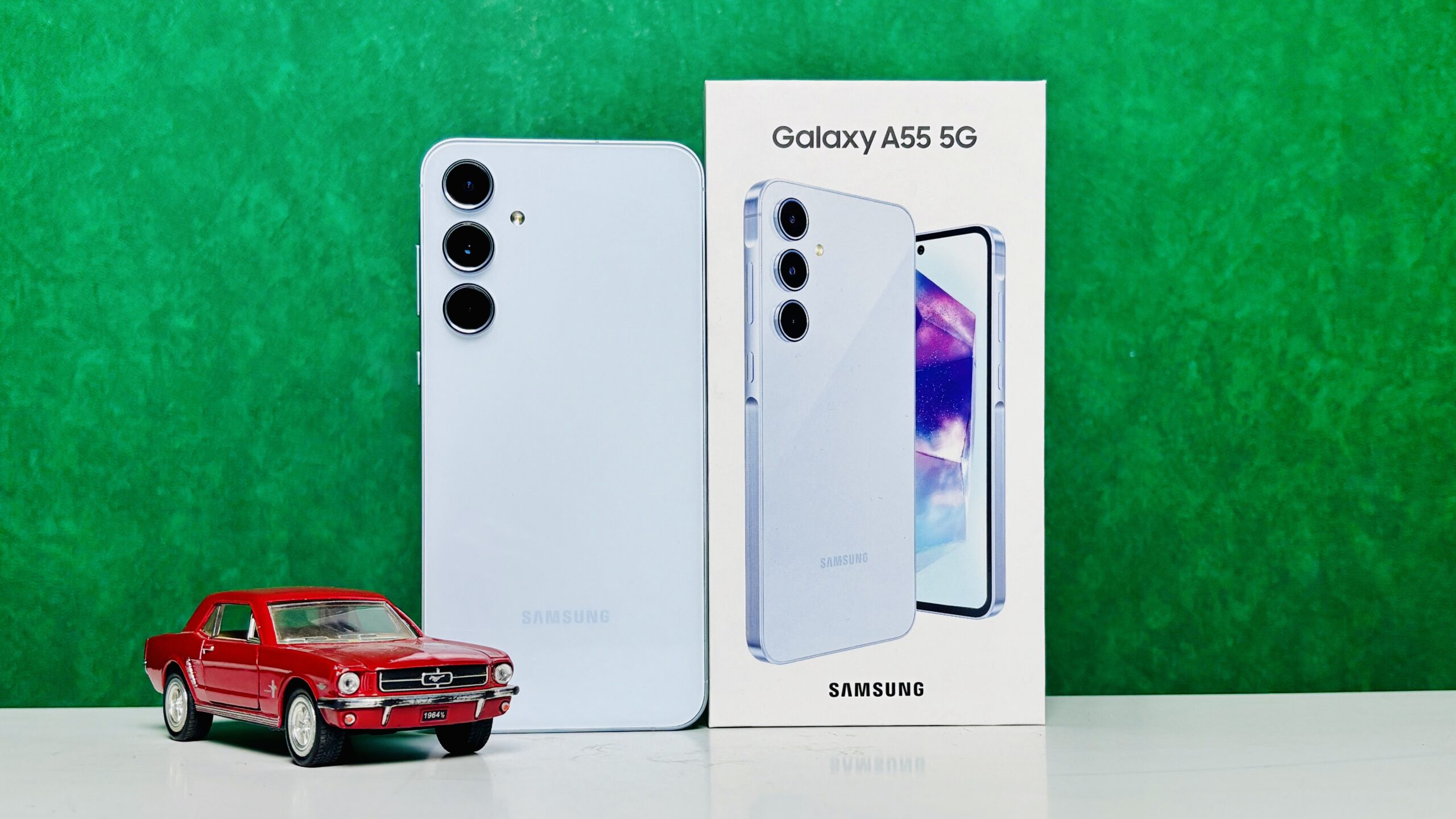In the rapidly evolving world of smartphones, the mid-range market is the sweet spot where affordability meets innovation. Samsung’s Galaxy A series has firmly established itself as a reliable choice for budget-conscious users. The latest addition to this lineup, the Galaxy A55, aims to carry on this tradition.
The Galaxy A55 brings several improvements over its predecessor. It showcases a more premium design, enhanced processing power, and a longer battery life. However, in a market saturated with options in the INR 40,000 price range, the Samsung Galaxy A55 faces formidable competition. Let’s dive into our review to see if it can successfully navigate this competitive landscape.
Samsung Galaxy A55: Design
Samsung has equipped the A55 with Corning Gorilla Glass Victus+ on both the front and back, ensuring superior scratch and shatter resistance. This high-end glass offers peace of mind for users who are prone to accidental drops.
Importantly, the design changes have not compromised the A55’s water and dust resistance. It maintains an IP67 rating, meaning it can withstand being submerged in up to 1 meter of water for 30 minutes.
In terms of button and port placement, the volume rockers and power button are conveniently located on the right edge, while the USB Type C and main speaker grill can be found on the bottom edge.
All in all, the design of the Samsung Galaxy A55 is a key selling point, offering a premium look and feel that is rarely found in the mid-range segment.
Samsung Galaxy A55: Display
The Full HD+ resolution on this display delivers a sharp and clear viewing experience. Text appears crisp and well-defined, while images and videos showcase impressive detail. While some competitors may offer higher resolutions, the A55 strikes a good balance between sharpness and battery efficiency.
The brightness of the A55’s display is another strong point. It reaches sufficient brightness for most indoor and outdoor environments, ensuring content remains easily readable even in well-lit areas. Additionally, the phone’s auto-brightness mode is particularly impressive. When exposed to direct sunlight, the display automatically boosts its brightness to over 1000 nits, ensuring visibility even on the brightest of days.
One minor issue we have with Samsung is the placement of the in-display fingerprint scanner, which tends to be a bit low. However, the scanner functions as expected, and there are no other complaints about its performance.
Samsung Galaxy A55: Software & UI
However, one drawback of One UI is the presence of bloatware. Pre-installed apps from both Samsung and third-party vendors can clutter the app drawer and detract from the overall user experience. While some of these apps can be disabled, not all of them can be uninstalled.
On a positive note, Samsung has made impressive strides in terms of software updates. The A55 is guaranteed to receive four years of major OS updates and five years of security patches. This ensures that users will continue to benefit from the latest security fixes and new features for an extended period of time. This level of commitment to software support is especially praiseworthy, particularly within the mid-range segment.
Performance
In terms of memory configurations, the Galaxy A55 offers versatility with options ranging from 8GB/128GB to 12GB/256GB.
For everyday tasks such as web browsing, social media use, and productivity apps, the A55 performs admirably. The Exynos 1480 handles these activities smoothly, providing seamless multitasking and minimal lag. App launch times are quick, and navigating the user interface is fluid.
While the A55 can handle casual games without any issues, more demanding titles may expose its limitations. The Exynos 1480 can run popular games at medium to high graphics settings, but users may experience occasional frame drops during intense gameplay.
One of the strengths of the A55 is its thermal management. Samsung has implemented a cooling system that effectively prevents the phone from overheating during prolonged use.
In conclusion, the Samsung Galaxy A55 offers more than sufficient performance for the average user. Its upgraded chipset and GPU deliver a noticeable improvement over its predecessor, positioning it as a strong contender in the mid-range market. Although it may not meet the expectations of power users, it strikes a commendable balance between efficiency and capability.
The Galaxy A55 utilizes the same 5,000 mAh battery as its predecessors, which already boasted impressive battery life. During our testing, we achieved over 6 hours of screen-on-time (SoT) with mixed usage. Unfortunately, the charging speeds are still limited to just 25W, resulting in a charging time of approximately 2 hours from 0 to 100%.
Camera
The Galaxy A55 is equipped with a triple-camera system on the rear, which is a common set-up in the mid-range smartphone market. This system includes a primary 50MP camera, a 12MP ultrawide sensor, and a 5MP macro sensor.
Samsung’s camera app on the A55 has a familiar and user-friendly interface. It offers a variety of shooting modes to choose from, including Pro mode for those who prefer more control over settings.
When it comes to camera performance, the primary camera excels in good lighting conditions, capturing photos with impressive detail and vibrant colors. Samsung’s image processing algorithms strike a good balance between sharpness and noise reduction. However, the sensor struggles in low-light situations, resulting in photos with noise and a lack of detail.
The ultrawide sensor is great for capturing expansive landscapes and group shots with minimal distortion, which is a common issue with ultrawide cameras. Colors are generally well-represented, and the level of detail captured is impressive for a sensor in this price range. On the other hand, the 5MP macro sensor is useful for close-up shots of flowers, insects, or other small objects. While it allows users to achieve a shallow depth of field and emphasize the subject, its low resolution limits its overall usefulness.
For selfie enthusiasts, the A55 has a 32MP front-facing camera. It captures detailed selfies with accurate skin tones in good lighting. However, similar to the rear cameras, its performance in low-light conditions is lacking. Selfies taken in dim environments can appear soft, but this is to be expected considering the price range of the product.

